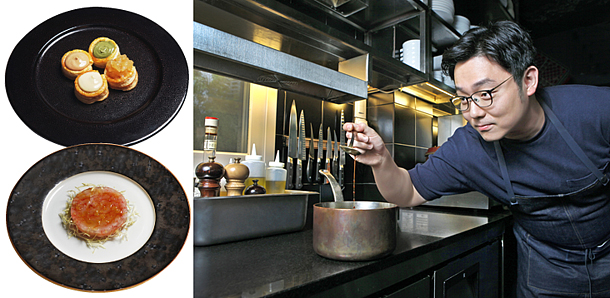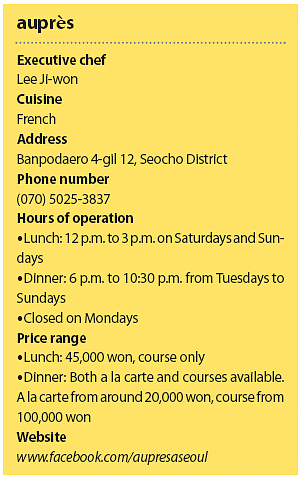An alternative approach to French

Chef Lee Ji-won of aupres, right, checks his sauce before dinner service in his kitchen that features a window that provides the opportunity for the chef to take a look outside while he is cooking. At left are two of the restaurant’s signature dishes; a dessert of vol-au-vent, top, and southern rough shrimp hardened in vinegar jelly, a raw seafood dish that is not often found in other French restaurants. [PARK SANG-MOON]
These final touches are key in enabling small French restaurant aupres to attract many regular diners. They have told executive chef Lee Ji-won that they can’t find a French restaurant like this anywhere else in Korea. Seeing as his dream was to create an irreplaceable restaurant, chef Lee seems to be on the right track.
His secret is the amount of time he spends on refining his signature seafood dishes - a different focus than many other French eateries that tend to concentrate on classic dishes like French onion soup or coq au vin. He also shies away from the heavy use of butter and cream, which are often considered essentials in French cooking. These traits have allowed the chef to create his own fresh and unique take on French cuisine.
“Just as people would have a hard time accepting deonjang jjigae (soy bean paste soup) prepared by a Westerner as a classic Korean dish, there is a limitation in doing French classic dishes as an Asian,” said Lee. “Then, what I can do is to create a new style that I can call mine and only I do.”

One of Lee’s most popular fish dishes is made with deokja, a relative of a fish species widely known as butterfish for its creamy texture. The fish, rarely used at other restaurants, is served with endive and a sauce made with garlic to make it simple as possible. He even ventures out to make a dish with raw seafood, uncommon in French cuisine, such as southern rough shrimp hardened in vinegar jelly. Here again, he ensures that the dish is simple so that the main ingredient is visible at first glance, and uses only some greens to garnish the seafood. His dessert, inspired by the puff pastry vol-au-vent, also adds unique flavors such as apple, jasmine tea and earl grey.
“Natural, simple, artisanal,” is what the first page of the restaurant’s menu says, which best describes the chef’s philosophy when he is preparing food. To live by these ideas, he installed a small window in his kitchen through which he can see the colors of the sky and the trees to keep up with the vibes that diners may bring with them to the restaurant, and to give himself a chance to breathe in what’s natural, simple and in style while at work.
“I’m different from the trend that people may call mainstream. What other chefs want to do isn’t what I want to do,” said Lee. “Based on my training, I know how to execute cooking techniques. What to pair with what ingredient should come from the back of my head, not from a fading memory of a dish that I once had long ago.”
While running the restaurant for more than two years, some of his experiments have become the signature dishes of the restaurant, such as a chicken stuffed with mushrooms and foie gras, and an appetizer with mussels and red peppers. These new approaches to French cuisine attract foodies in Korea without him needing to work hard at promoting his restaurant, despite the fact that it is located far away from the restaurant-heavy Gangnam district in Southern Seoul. The buzz around the menu at aupres even earned Lee the title of “Young Chef of the Year” from the 2016 edition of the Blue Ribbon Survey, one of the most widely known restaurant review guides in Korea.
“The rookie award is very important for me because it tells me that I am going in the right direction, and people have given me the green light to continue to go forward on this track,” said Lee adding that the award has led to more traffic to his restaurant.
“I want many other aspiring chefs out there to know that even when they think they don’t do food that is considered mainstream, they can still make it work, and taking that challenge is crucial in terms of diversifying what’s available in Korea.”
BY LEE SUN-MIN [summerlee@joongang.co.kr]










with the Korea JoongAng Daily
To write comments, please log in to one of the accounts.
Standards Board Policy (0/250자)